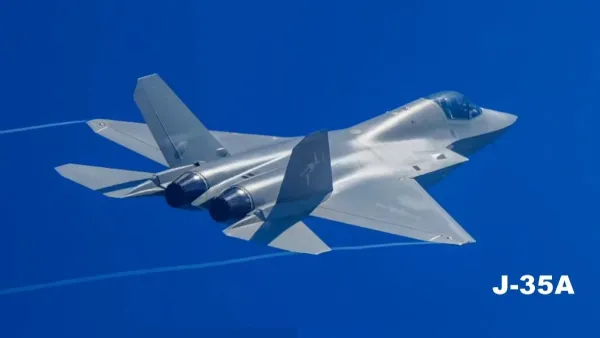
New Delhi: The Chinese imprint on Pakistan armed forces is set to deepen further as reports suggest that Beijing is fast-tracking the delivery of its fifth-generation J-35A stealth fighter jet to its long-time ally.
Islamabad is said to have finalised the purchase of up to 40 of these stealth fighters from China. If the delivery takes place, it will mark the first international export of the aircraft which was unveiled in Zhuhai Air Show in November last year.
Pakistan, the reports suggest, placed its official order in December 2024, with delivery of over 30 fighters anticipated between August 2025 and early 2026.
The deal is being hailed in the two countries as a game-changer for the Pakistan Air Force (PAF). The aircraft will complement and enhance the PAF's modernisation drive, which includes recent inductions of the JF-17 Block III and J-10CE fighters.
Currently, India is pursuing its own project to develop a fifth-generation stealth fighter jet-the advanced medium combat aircraft (AMCA). On Thursday, Defence Minister Rajnath Singh announced the approval of the AMCA programme execution model.
Developed by Shenyang Aircraft Corporation (SAC), a subsidiary of the state-owned Aviation Industry Corporation of China (AVIC), the J-35 is a twin-engine stealth multirole fighter evolved from the FC-31 Gyrfalcon prototype-a once privately funded project aimed at the export market after SAC lost the J-XX program bid to Chengdu Aircraft Industry Group.
First introduced as the 'F-60' at a Beijing innovation contest in September 2011, the FC-31 took to the skies on 31 October 2012. Although initially outside China's official military development stream, growing interest from the People's Liberation Army (PLA) and the PLA Navy prompted the FC-31's transformation into two formal variants: a land-based J-35A for the PLA Air Force (PLAAF) and a carrier-based version for the PLA Naval Air Force (PLANAF).
As of now, China is the only country besides the US (F-22 and F-35) to field two operational fifth-generation stealth fighters-the Chengdu J-20 'Mighty Dragon' and the Shenyang J-35. While the J-20 is tailored for long-range air superiority, the J-35A offers multirole versatility with a lighter footprint and greater export potential.
Copy cat?
The J-35A is reported to come with next-generation avionics, sensor fusion systems, and a weapons payload capacity of up to 8,000 kg-2,000 kg internally and 6,000 kg externally.
What catches the eye is the striking similarity it shares with the F-35 that often led to the accusation of the Chinese copying the American stealth fighter, a charge that has stuck with the Asian powerhouse given its notoriety of cloning technology either borrowed or stolen from Russia and the West.
While both the J-20 and J-35A feature stealth and advanced avionics, they serve distinct roles. The J-20, with its larger airframe, more powerful WS-10C or future WS-15 engines, and extensive sensor suite, is designed for long-range air dominance.
In contrast, the J-35A offers multirole agility and is tailored for medium-range missions. The J-20 remains China's flagship stealth platform, while the J-35A opens new possibilities for China's defense exports and allied force multipliers.
The arrival of the J-35A in Pakistan will be a defining moment in South Asia's military landscape. Analysts suggest that the new stealth fleet could give the PAF a 7-14 year advantage in fifth-generation capability over India, depending on the AMCA timeline.
The platform's success will depend heavily on seamless integration with Pakistan's existing infrastructure and China's continued support in training, logistics, and maintenance.
Once operational, the aircraft will not only elevate Pakistan's aerial combat abilities but also underscore China's growing influence as a global defense supplier and stealth aircraft innovator.
Aditya Shrikhande is an intern who graduated from ThePrint School of Journalism.